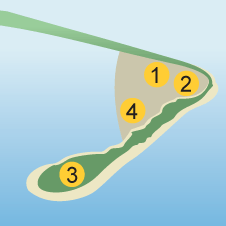Spits are also created by deposition. A spit is an extended stretch of beach material that projects out to sea and is joined to the mainland at one end.
Spits are formed where the prevailing wind blows at an angle to the coastline, resulting in longshore drift.
The development of Spurn Head 
- Longshore drift moves material along the coastline.
- A spit forms when the material is deposited.
- Over time, the spit grows and develops a hook if wind direction changes further out.
- Waves cannot get past a spit, which creates a sheltered area where silt is deposited and mud flats or salt marshes form.
*Longshore Drift - A tide or current that flows along the coast, taking material with it.
Comments
No comments have yet been made